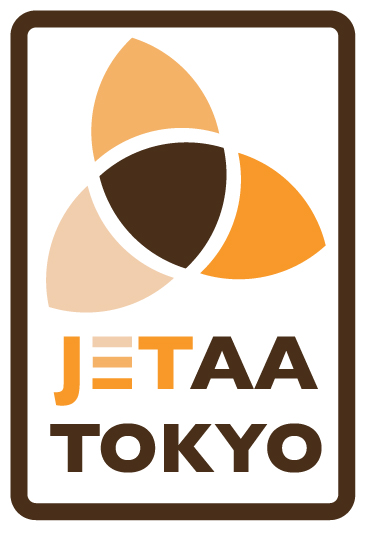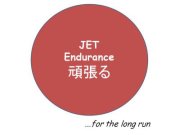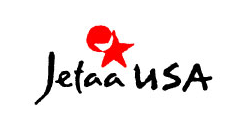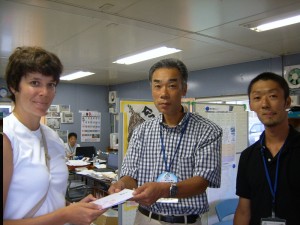Xmas cards for Tohoku kids
Via JETAA USA:
Xmas Cards for Tohoku Kids
http://www.jetaausa.com/?p=1952&preview=true
A Professor Emeritus of Chuo University has started a project called “Xmas Cards from Friends Around the World”. This is a campaign to gather Christmas cards from around the world to bring to the children in Tohoku. If you’d like to participate, please send your card(s) to the following address:
c/o Mrs. Mayumi Hoshi
Shichigahama-cho Saigai-Volunteer Center
Noyama 5-9, Yoshidahama
Shichigahama-cho, Miyagi
JAPAN 985-0802
ATTN: Boys and Girls
For more information (Japanese only) please see the PDF.
Summary of JETAA USA Fund disbursements
***************
Thanks to JETAA USA Country Representative (and JETAA USA Fund Committee member) Megan Miller (Hyogo-ken) for the following summary of the JETAA USA Earthquake Relief Fund’s disbursements. It was originally an e-mail sent to the JETAA USA chapter officers Google Group which has been modified slightly for posting here:
Dear US Chapters,
The fund committee has been hard at work and has finalized the donations for the $76,000+ we have raised so far. I’d like to thank the committee as well as the folks at JETAANY for all of their hard work during the past 8 months, and I’d also like to thank all of you for your amazing fundraising efforts. News of JETAA’s collective, world wide fundraising efforts as JET Alumni is very much on the radar screen in Japan. It is great that we can support the people of Japan and also demonstrate the value of our network and our commitment to Japan at the same time.
To recap the fund committee’s decision, here is where we are allocating the funds raised to date:
1. Hope for Tomorrow – $25,000 (http://hope-tomorrow.jp/)
A major challenge that high school students from the Tohoku region will face is to keep from falling behind students from elsewhere in the country who are studying for their college entrance exams. The students in Tohoku graduating this March had completed their exams by the time of the earthquake, but the ones who will graduate next year are liable to fall behind due to the length of time schools have been shut down, the absence of cram schools and other supplementary educational activities during their senior year, and the trauma and family tragedies that many have to face. On top of this, they need sufficient resources to even take the university exams, which tend to require travel to Tokyo, Sendai or Hokkaido. The exam fees are likely to be waived for many students, but there is no system to support their personal travel, lodging, meals, etc. when they leave their hometowns to take the entrance exams. In many cases, these expenses can easily exceed US$1,000, which will be difficult for families who have lost their homes and businesses to muster.
In response, a group of Tokyo volunteers has launched a new NPO called “Hope for Tomorrow” that plans to help support students by covering these expenses. They have been in touch with the main high schools in Kessennuma and Ishinomaki about this initiative. Kessennnuma had the greatest need, so they have come to an agreement with the high school to start supporting their students, and they hope to expand to other schools, including Ishinomaki’s high school. They are also interested in expanding to Rikuzentakata and open to other suggestions from us about other places. (In May, they tried to speak with the Rikuzentakata authorities as well as those in the neighboring town, Ofunato, where students were attending high school since Rikuzentakata’s high school was badly damaged, but were unable to have discussions due to the overwhelming challenges school officials were facing. However, they hope to try again soon.) In addition to the helping with the exam fees, they also wish to provide mentoring services to the students and other support that can aid them before and after their exams.
Update: They have expanded to Takata High School (the Rikuzentakata HS, although temporarily being operated in an empty school in Ofunato), because of our funds. Takata High School is delighted, and things are all firmed up now. They are also operating in Kessennuma, and might expand into Ishinomaki or elsewhere if there is additional funding.
2. E.Pa+Ch – $25,000 (http://soup1993.com/epatch.html)
E.Pa+Ch stands for Youth Empowerment Iwate (direct translation: Empowerment through Participation and Challenge). This group was created by a professor at Iwate Prefectural University (IPU) who has been active in mobilizing college volunteers to work in the disaster zone through a project called “GingaNet.” The group is planning to launch a major initiative throughout the prefecture to provide tutoring to and study rooms for middle school students who have fallen behind in their studies, with IPU students acting as volunteer tutors. (This may be expanded to high school students taking university entrance exams, in which case professional juku teachers will need to be employed). The board of education expressed support for this, and the IPU professor, Yamamoto-sensei, is going to continue developing the program in consultation with the board. This innovative program was launched on Nov 1, and it possibly will be a model for other programs around Tohoku. CR Jess Wilcox and Fund Committee member Jim Gannon were interviewed regarding our involvement. Read the article here: http://www.yomiuri.co.jp/dy/national/T111104005277.htm
3. Rikuzentakata Board of Education – $10,000
This direct contribution to the BoE will help alleviate some immediate needs of the schools, possibly including the hiring of a second JET for the area. There is currently a JET in RT who replaced Monty Dickson and the BoE would like to hire a second.
4. Taylor Anderson Memorial Fund – $5,000 (http://www.st.catherines.org/tayloranderson )
Many of you are already familiar with the work that the Anderson Family has been conducting. We have made a $5,000 donation to their fund to demonstrate our collective support.
5. Grants for 2-3 JET-related orgs – $10,000+ (To Be Finalized)
We are working with Paul Yoo of volunteerAKITA and Living Dreams who worked with Mike Maher King (Smile Kids Japan). Our grants will help support their grass roots efforts of volunteering in the area, bringing in needed supplies, and ‘filling in the cracks’ where other NGO’s are unable to assist.
TOTAL = $76,000+
Also, many of you might be aware that the JETAA international meeting was held in Tokyo from Oct 21-22. The meeting was covered and televised by NHK news. We also met with various government ministers who thanked us for our efforts to support Japan and asked us for advice on improving the JET program.
After the meeting we volunteered alongside current JETs in Rikuzentakata. We are doing a write up of that emotional experience and will send it to you in the coming days. Being in Rikuzentakata really drove home how important our efforts are. We have the power to get our funds directly in the hands of the people making decisions on the reconstruction effort.
To that end we would like to encourage JETAA chapters to continue fundraising. We now have connections on the ground and can help deploy funds efficiently and effectively. We have been notified that JETAANY will not be able to host the fund next year due to tax reasons, but we will work to find another nonprofit chapter that can help support us. Thank you again JETAANY for all the extra work you took on this year to make the fund a reality!
Lastly, it is always helpful when the JET alumni community is able to remind others of the ongoing needs in Tohoku and share news of JETAA’s accomplishments with others. I strongly encourage each of you and your chapter members to reach out to local news publications, church newsletters, your college and HS alumni magazines, work newsletters, chapter newsletters, etc. A great deal of information can be found on JETwit and the JETAA USA website. You can also contact members of the JETAA USA Fund Committee or local chapter officers if you need additional information or an official representative or spokesperson.
Stay tuned for more detailed information to follow.
JETAA Tokyo collaborates with Tokyo de Volunteer for trip to Miyagi
 Via JETAA Tokyo:
Via JETAA Tokyo:
JETAA Tokyo is pleased to support Tokyo de Volunteer in their “Beauty de Volunteer” volunteer activities. This time, Tokyo de Volunteer is organizing a volunteer trip to Tohoku region to participate continuing relief and recovery effort. Participants will be providing free beauty services (such as haircuts, make-up, etc.) in order to boast morale in Higashimatsushima. If you do not have any beauty or special skills, there will no doubt be other ways to contribute at the volunteer center. Simply visiting the region is meaningful gesture to support their still difficult daily life.
As these trips have received corporate sponsorship, free bus transportation to/from Tokyo will be provided. If you would like to stay longer in Tohoku to travel, you can do so, or join Tokyo de Volunteer at the volunteer site and come back on the bus with the group. You may as well, simply stop by and join the group for a day of volunteering. If you are interested in participating in this activity, please contact tokyo.de.volunteer@gmail.com directly with the date you would like to participate.They will reply with a confirmation with details application and information.
1) Higashimatsushima Trip
Departs: Friday, October 21, 23:30 from in front of the Marunouchi Building at Tokyo Station
Volunteer: Saturday, October 22
Return: Tokyo, October 22, 21:00
For more information about Tokyo de Volunteer and available volunteer opportunities, please click here: http://tkdv.blogspot.com/
Miyagi JET alums organize Hong Kong fundraiser
******************
Thanks to Osaka JET Cailin Arena for letting us know about this:
From Miyagi JET alum Monique Moloney: “Here is the press release (and photos) for the fundraiser in Hong Kong on April 16. It was a great way to connect with the Japanese community in Hong Kong and to put our energy towards a positive outcome for Miyagi.”
********************
FOR IMMEDIATE RELEASE
Former Miyagi Residents Raise Funds Through Hong Kong Event
Hong Kong – 25th April, 2011
Two former residents of Miyagi Prefecture have pooled the creative expertise of five photographers in a silent photographic auction in Hong Kong to raise money for the March 11 earthquake and tsunami relief efforts.
The event entitled “Kampai for Sendai” was held on Saturday, April 16 at Shore Restaurant and Bar and was attended by approximately 180 people. The silent auction of distinctly Japanese photographs including 13 original mounts and three canvassed photographs, was the main focus of the evening. Additional funds were raised through the live auction of Simone Legno autographed Tokidoki merchandise and the sale of raffle tickets.
The total amount raised from the event was HK$30697 (US$3950). 100% of these funds were be donated to Peace Winds Japan andShine Humanity, two non-government organisations that have been highly visible in Miyagi Prefecture and are committed to using all designated funds for the Japan relief effort.
The event organizers, Monique Moloney and Matt Jones, both Australian nationals living in Hong Kong, were Assistant Language Teachers on the JET Programme in Miyagi Prefecture between 2003-2006. Having maintained strong connections with their former home, they were deeply affected by the devastation and suffering in communities where they’d often visited and fondly remembered. Their reaction was to organise an event that could raise awareness and funds in a meaningful way.
Through online groups, Monique found photographers who were willing to contribute their work to the cause. She also connected with other former JET participants who were living in Hong Kong. These people helped promote the event and attended to show their support.
“We may have moved on but we haven’t forgotten our friends in Miyagi Prefecture. It was our turn to give back for the kindness and good will we were shown during our time there.”
For more information, please contact Monique Moloney at mnqmlny@gmail.com or phone +852 90300243
Video: NHK covers JETAA International Conference in Tokyo and JETAA fundraising efforts
****************
Here’s a link to a 1.5 minute NHK news story (video) about the JETAA International Conference just held in Tokyo. The story also references the approximately $500,000 raised for earthquake relief by JET Alumni Association chapters around the world.
http://www3.nhk.or.jp/news/html/20111021/t10013420671000.html
The video includes a brief interview with Akita JET Paul Yoo, founder of volunteerAKITA and The Fruitree Project, who attended the conference. Also visible in some of the shots are JETAA International Chair Shree Kurlekar (Shiga-ken) and JETAA USA Country Reps Megan Miller (Hyogo-ken) and Jessyca Wilcox (Hokkaido). (Those are the people I recognized. If you recognize others, please post in the comments section.)
The JETAA International Conference attendees are also scheduled to participate in a JET-led volunteer trip to Rikuzentakata this weekend.
Here’s the NHK article that accompanies the video:
外国語指導助手ら 被災地支援強化
10月21日 15時37分
日本国内で英語などの外国語の指導助手として働いた経験を持つ外国人たちが連携して、東日本大震災の被災地の支援を強めていくことになりました。
日本政府が、昭和62年から続けている中学校や高校などで英語の指導助手として働く「JETプログラム」と呼ばれる事業の参加者は、21日、都内で会議を開き、被災地への支援について話し合いました。会議には、アメリカやイギリスなど世界10か国から20人が参加し、英語の指導助手を務めた経験を持つアメリカ人の女性は、被災地の中学生の補習授業や高校生の大学受験に充てるために、友人や知人などから集めたおよそ600万円を寄付することを報告しました。また秋田県の小中学校で英語の指導助手を務め、避難所でボランティア活動を続けているアメリカ人のポール・ユーさんは「ボランティア活動を始めた際、1人では何もできなかったが、仲間のネットワークが役立った」と述べ、日本をよく知る外国人が連携して被災地の支援を強めていくことを確認しました。東日本大震災では、宮城県石巻市と岩手県陸前高田市で英語の指導助手をしていたアメリカ人2人が津波の犠牲になっています。
JETAA USA Earthquake Relief Fund announces recipients
Below is the official press release (in English and Japanese) announcing the recipients for JETAA USA Earthquake Relief Fund to the media in Japan.
FYI, a lot of hard work has gone into this process, using our JET contacts, bilingual and bi-cultural abilities to identify appropriate and worthy uses for the approximately $75,000 raised by the JETAA chapters in the U.S.
JETs and JET alumni should be extremely proud of the ways we’ve been able to support Japan in the wake of the 3/11 crisis. Many larger organizations have faced significant challenges in finding appropriate grantees, due in a large part to a very different and smaller Japanese non-profit sector that continues to grow and evolve in new ways. Our quasi-Japanese expat community of 55,000+ JET alumni spread around Japan and the world has been uniquely positioned to help meet these challenges.
Also worth noting is that the JETAA International meeting is taking place this week in Tokyo. JETAA representatives from each country are attending and will be participating in a JET-led volunteer effort in Rikuzentakata with the help of JET Paul Yoo, founder of volunteerAKITA and The Fruitree Project. JETAA International Chair Shree Kurlekar (former JETAA New York Vice-President) and other representatives will also be speaking with the Japanese media.
Thank you to JETs, JET alumni and Friends of JET everywhere who have contributed to the fund, volunteered their time, volunteered their translation and other skills and supported Japan in many other ways as well.
Ganbarou Nippon!
**************
PRESS RELEASE – ENGLISH VERSION
**************
JETAA USA Earthquake Relief Fund
In its 25-year history, more than 55,000 people from 60 countries have participated in the JET (Japan Exchange and Teaching) Program, developing strong ties with communities around Japan. Thanks to the years they spend in Japan, it is fair to say that JET participants come to view Japan as their second home, and most continue to maintain active connections with Japan after leaving the program. The most common way for JET alumni to stay connected is through the 50+ chapters of JET Alumni Association (JETAA) worldwide, which bring alumni together to share their experiences and to promote ties with Japan in their home countries.
Even JET alumni who did not have friends and family in the Tohoku region were deeply moved by the tragedy that unfolded there. In response, all 19 chapters of JETAA USA came together in March 2011 to launch the JETAA USA Earthquake Relief Fund to support educational needs of communities in the disaster zone. Since March 11, the fund has raised $76,000 (5.8 million yen) from the U.S. JET alumni community.
Rikuzentakata and Ishinomaki have special significance for JET alumni since two of their colleagues lost their lives while teaching and living in these communities. Therefore, JETAA USA has decided to donate funds to programs in these two areas, with a primary focus on educational initiatives in Rikuzentakata. The aim is to improve the prospects of students who have been affected by the disaster, carry on the spirit of the JET Program and give back to the country that found its way into the hearts of JET alumni. Grants are being made for the following initiatives:
Hope for Tomorrow support for university applicants from Rikuzentakata ($25,000)– The costs of university entrance exams are a heavy burden for Japanese families and can be especially formidable for families affected by the disaster. Hope for Tomorrow, a new nonprofit organization, will defray exam fees and/ or associated travel and lodging costs in order to support Takata High School (located in Rikuzentakata) students applying to university. JETAA USA will financially support this program in Rikuzentakata.
Rikuzentakata tutoring project ($20,000) – Students in Rikuzentakata have been through traumatic experiences and lost considerable class time. The nonprofit organization Youth Empowerment Iwate, in cooperation with other groups, is launching a new initiative through which university students will provide extracurricular tutoring for middle school students while also using these sessions to lend a sympathetic ear to students who may feel intimidated discussing their concerns with older adults.
Rikuzentakata City education project ($10,000) – A special grant is being made to support JET-related activities and English teaching in the town.
Taylor Anderson Memorial Fund ($5,000)– The Taylor Anderson Fund is supporting a range of innovative programs in Ishinomaki, where JET Taylor Anderson taught and lived, including the exchange programs for local students and “reading corners” at elementary schools.
JETAA USA supporting JET participants ($10,000)– JET-run organizations and programs such as volunteerAKITA (which has been mobilizing JET participants to provide disaster aid since mid-March 2011) have responded to the disaster and recovery efforts. Individual grants are being made to help them sustain their disaster-related activities.
****************
PRESS RELEASE – JAPANESE VERSION
****************
米国JET同窓会(JETAA・USA)日本震災復興支援基金
平成23年10月21日
JETプログラムは、今年で25周年を迎え、これまで50カ国以上から5万5000人以上の外国青年の参加を得てきた。彼らの多くは、日本全国の地域コミュニティに深くとけ込み、その貴重な経験から、帰国後も日本を第二の故郷と考え、日本との関係を保ち続けている。JET同窓会(JETAA)は全世界に50以上の支部を持ち、多くの元JET参加者がJETAAを通じて、日本の経験を共有し、日本と母国の絆を深める活動を展開している。
今般の東日本大震災は、元JET参加者に大きな衝撃と悲しみをもたらし、元JETの間では支援の輪が直ちに広がった。米国では、JETAAの全19支部が協力し、3月中に米国JET同窓会震災復興支援基金(以下「米国JETAA基金」)が立ち上げられた。同基金は、被災地の教育支援に充てられることとなっており、これまでに約76,000米ドル(約580万円)の支援金が集められた。
今回の震災で犠牲になった現役JET二名が在住していた陸前高田市と石巻市は、元JET参加者にとっても特別な意味を持つ。米国JETAAは、支援にあたって同2市に重点を置き、特に陸前高田市の教育関係への支援を優先的に実施することとした。(石巻では、テーラー・アンダーソン追悼基金が数々の支援を行っている。)米国JETAAではこの支援を通じて、被災地の子供たちの将来への可能性を広げ、JETプログラムの精神を引き継ぎ、元JET参加者が心から大切に思う日本という国に恩返しをしたいと考えている。下記の事業へ寄付が行われる予定である。
Hope for Tomorrow進学支援プログラム($25,000):高校生の大学受験費用は一般家庭でも大きな負担となっているが、被災した家庭にとっては背負いきれないほどの負担となる。Hope for Tomorrowは新しく立ち上げられたNPOで、高田高校の学生を対象に大学受験にかかる旅費や宿泊費などの諸費用を支援する活動を行う。
陸前高田学習支援プロジェクト($20,000):壊滅的な被害を受けた陸前高田では、多くの学生が精神的なダメージを受けた上、学習の時間も大幅に失った。NPO「子どものエンパワメントいわて」は、他の恊働団体と共に大学生ボランティアによる中学生を対象とした学習支援活動を行う。本プロジェクトでは学力向上だけでなく、被害を受けた子どもたちのケアを重視し、勉強の合間に子ども達が自然と話したくなったことを傾聴し、対話しながら学習支援を行う。
陸前高田市内教育プロジェクト($10,000): JET関連の活動と英語教育を支援するための特別寄付を行う。
テーラー・アンダーソン追悼基金($5,000):同基金では、テーラー・アンダーソンさんが英語を教えていた石巻において、地元学生の交流プログラムや小学校での「読書コーナー」設置など、幅広い分野で革新的な事業を支援している。
JETのボランティア活動支援(約$10,000):現役のJETや元JET参加者が運営する複数の団体が被災地の支援活動を行っている。これらの団体が活動を継続できるよう支援を行う。
米国JETAA基金は様々な活動を通じて集められた。
(募金活動例)
JETAA北部カリフォルニア支部(本部サンフランシスコ市):募金イベント“Japan Relief Fundraiser”を、ホテル・カブキのO(オー)居酒屋ラウンジにて実施。150人以上の参加があり、寄付と抽選が行われ、地元紙にも取り上げられた。
JETAAミネソタ支部:募金イベント“Japan Benefit Party”を、居酒屋・基(Moto-i)(海外初の店内で醸造した日本酒を提供する店)で実施。DJ、ライブ音楽で会場を盛り上げ、サイレント・オークションが行われた。
JETAAワシントンDC支部所属の元JET2名が7月に結婚した際、招待客からの贈り物を辞退し、その代わりに寄付をするよう呼びかけた。
JETAAニューヨーク支部:300人以上が参加する大規模募金イベントを実施、日米双方のテレビ及び主要紙に取り上げられ、ニューヨーク在住元JETからの応援メッセージがメディアを通じて日本に届けられた。
米国JETAA基金は、元JET参加者による支援活動のほんの一部に過ぎない。JETAAの全米各支部は、この他にも様々な募金活動をしており、同基金とその他の活動による募金を合わせると全米JETAAによる支援金総額は31万3000米ドル(約2440万円)に上る。支部によっては、既に日本赤十字、ジャパン・プラットフォーム、ピースウィンズ・ジャパン等の日本の団体に直接寄付を行っている。また、一部の支部は、日米協会等米国の現地団体の募金イベントに協力し、積極的な役割を果たしてきた。
米国JET同窓会(JETAA・USA)
| 全世界の元JET参加者のうち、約半数が米国人であり、米国にはJET同窓会(JET Alumni Association, JETAA)が19支部存在する。各支部は、全てボランティアベースのメンバーにより運営され、元JET参加者のネットワークを維持・強化し、文化・交流・教育事業やチャリティ事業等の実施を通じて、日米関係の一層の深化を図っている。米国JET同窓会の活動の詳細、同会震災復興支援基金への寄付はこちらから: HYPERLINK “http://www.jetaausa.com” www.jetaausa.com |
Return to Tohoku: Alma Jennings goes back to Iwaki City in Fukushima
***************
Thanks to JET alum Christy Jones of the Japan Society in New York for letting JETwit know about fellow JET alum and Japan Society colleague Alma Jennings (Fukushima-ken, Iwaki-shi) who has written about her return to Iwaki City in Fukushima where she went to volunteer and reconnect with old friends and colleagues.
Here’s a link to Alma’s writing on the Japan Society website: http://www.japansociety.org/page/earthquake/updates_from_japan
Here’s the intro from the Japan Society website:
“Like many young Americans interested in Japan, Alma Jennings, a Development Assistant at Japan Society, participated in the JET Programme and lived and taught English in Iwaki City on the southern coast of Fukushima Prefecture between 2008 and 2010. In September 2011, Alma returned to Iwaki City to visit her friends, former colleagues and students. She also went to the Iwaki City Volunteer Center to volunteer. Here is the first-part of a three-part series on her experience.
CLICK HERE to read more Return to Tohoku posts by other JET alums.
PNW JETAA’s meeting with Hyogo Governor Ido and Ryan Hart’s speech
On Friday August 26, we had the great honor of giving a presentation about the Pacific Northwest JET Alumni Association at the Hyogo Seminar, which was hosted by Hyogo Prefecture (coordinated by theHyogo Business and Cultural Center) and the Council of Local Authorities for International Relations (CLAIR). The Governor of Hyogo Prefecture, Toshizo Ido, gave a comprehensive presentation on the many great qualities of Hyogo. Consul General Kiyokazu Ota, Masaaki Akagi, the Executive Director of The Japan Local Government Center (CLAIR New York), and Ginn Kitaoka, the Executive Director of the Hyogo Business and Cultural Center all gave warm opening remarks.
During our presentation, we highlighted the great things our chapter does. Ryan Hart (Chiba-ken, Ichihara-shi, 1998-99) (former PNW JETAA President, JETAA USA Country Representative and JETAA International Vice-Chair) shared what JETAA and current JETs are doing on the national and international level, Karin Zaugg-Black shared how her JET experiences shaped her career and her personal involvement with Japan, and Erin Erickson explained how we have supported Japan Relief efforts. Leela Bilow, Jana Yamada, and Casey Mochel shared their memories of Japan and how they continue to be involved with the Japanese community after JET.
Ryan Hart very generously allowed us to share his speech with you. Below is a brief excerpt, and his full speech is below the cut.
From its inception, the JET Alumni Association has helped former participants of the JET Program “Bring Japan Back Home.” What does this mean? We help former participants network, make new friends and transition their careers. We help the JET Program by recruiting, interviewing and training new teachers for their journey. We also help our communities we live in to support Japanese culture and raise awareness of the strong ties between our countries.
On March 11, 2011, like so many other things in our lives, this changed. Instead of “Bringing Japan Back Home”, our chapters and membership have rallied not only to raise money for immediate earthquake and tsunami relief, but also to strengthen the value of our relationship with local communities and organizations in Japan.
The JET Program, since 1987, has grown into the largest and most successful work exchange program in the world. Each year, the program brings thousands of teachers to Japan to promote language education and to strengthen Japan’s relationship with a number of countries. Since 1989, our Alumni Association of former program participants, has mirrored that growth and has steadily grown as a true grassroots organization, built from our individual members up. JETAA is now 53 chapters in 18 countries. As a former chapter president here in Seattle, a former Country Representative for JETAA USA’s 19 chapters and as former Vice Chair for JETAA International, I have been truly blessed to have had the chance to work and be a part of this growth.
From its inception, the JET Alumni Association has helped former participants of the JET Program “Bring Japan Back Home.” What does this mean? We help former participants network, make new friends and transition their careers. We help the JET Program by recruiting, interviewing and training new teachers for their journey. We also help our communities we live in to support Japanese culture and raise awareness of the strong ties between our countries.
On March 11, 2011, like so many other things in our lives, this changed. Instead of “Bringing Japan Back Home”, our chapters and membership have rallied not only to raise money for immediate earthquake and tsunami relief, but also to strengthen the value of our relationship with local communities and organizations in Japan.
- Immediately following the earthquake and tsunami, JETAA USA started raised money as a national organization and chapters voted to allocate this money directly to the affected local communities. We have formed a national advisory committee for the relief fund, of which I am proudly serving as a member. To date, the JET alumni have raised over $60k in funds and we are exploring continued fundraising efforts to make an even bigger impact.
- AJET, as an organization of current JETs living and teaching in Japan, has been partnering with organizations such as Peace Boat, Second Harvest, Foreign Buyers Club and 5toSurvive to raise money and awareness of recovery efforts. The Osaka AJET Chapter has worked on food drives with Kozmoz International of Kyoto, and have driven food and supplies themselves to Tohoku from Osaka.
- Mike Maher-King, a Fukui JET, formed Smile Kids Japan, a program of visiting orphanages throughout Japan. After March 11, he partnered with an organization in Tokyo called Living Dreams to start the Smile & Dreams project for Tohoku children to make sure the needs of the orphanages and the needs of the children who rely on them are met. He recently presented at TED Talks in Tokyo.
- Paul Yoo, an Akita JET, founded the Fruit Tree Project (delivering $23,571 worth and 38,612 items of fresh fruit to Tohoku) and VolunteerAkita, which was the backbone of the BIG CLEAN project that was directly involved in the cleanup of Kessenuma. He is now working as the Home Communication Manager for two orphanages in Sendai to ensure their needs are communicated with organizations involved with relief efforts.
- Hotdogs and Hugs was an aid organization of JETs from Saga-ken, who traveled from Saga Prefecture in western Kyushu, all the way to Tohoku, raising awareness and funds for relief efforts along the way.
- Save Miyagi was founded by Canon Purdy, a JET Alumni who was in Miyagi-ken.
- Billy McMicheal, a CIR in Fukushima, has formed Hearts for Haragama, which is raising funds for the Haragama Youchien Kindergarten in Soma, Fukushima.
- Kat Geeraert, an alumnus who also lived in Soma, has started Friends of Soma to raise money for relief efforts.
These are just a few examples of the direct impact JETs and JET alumni have had. Given the number of teachers who have taught in Japan since 1985, there probably are many more individual efforts out there that we don’t know about.
What we do know is that, in light of what happened on March 11, JET alumni around the world are not only focused on “Bringing Japan Home”, but also “Bringing Home to Japan.” Collectively, we have a renewed focus not only on strengthening US/Japan relations, but also the ties with the communities we once lived, worked, and taught in. We know that our contracts we were given to us by local governments and boards of education throughout Japan, weren’t just annual contracts, they were invitations to a legacy. It should be very clear to the many communities across Japan who have invested in the JET Program since 1987 that there is a long-term value in the relationships that have been formed with the many JET Program participants that have come and gone. Whether it be through media campaigns, tourism promotion, school exchange programs, or relief and fundraising efforts, JETAA is now looking to continue our legacy in “Bringing Home Back to Japan.”
Thank you.
Ryan Hart, Ichihara City, Chiba Prefecture, 1998-99
*****************
With increased potential for budget cuts to the JET Programme and to JETAA and additional prefectures opting to use private ALTs rather than JETs, it’s good to see an example of a prefecture making effective use of JETs to provide significant Return on JET-vestment.
Toyama Prefecture has for the past two years been using its CIRs & ALTs to promote tourism through their Twitter and FB accounts or other means. More explanation is available in Japanese at: http://www.pref.toyama.jp/cms_press/2011/20110915/00007707.pdf
This year, according to this notice, they were planning to take their six ALTs (4 Americans) and two CIRs (both Americans) around to the big tourist attractions and then have them put out word-of-mouth to promote them, through Facebook, Twitter, blogs, or actual word-of-mouth after they go home.
There’s no reason other prefectures can’t adopt similar programs with their JETs and CIRs and why JETs and JET alums themselves can’t initiate this kind of activity.
While it’s relatively easy for local governments to find native English speakers to teach in their schools, it’s much harder to bring in teachers who will feel a connection to the community that lasts a lifetime and continues to provide tangible and intangible benefits over the long term. And that is the power of the JET Programme.
Return to Tohoku: “Don’t Speak, Just Move On” by Audrey Shiomi
*******************
The following is a personal essay by Audrey Shiomi (CIR Miyagi-ken, Sendai-shi, 1999-2001). Through generous sponsorship by Japan’s Ministry of Foreign Affairs, she spent a week in September visiting her former residence in Sendai City, one of the areas affected by the March 11 earthquake. In lieu of volunteering in disaster-stricken regions, she spent each day meeting with friends and former coworkers to listen to their stories.
Click here to read other Return To Tohoku updates on JETwit. You can also check the JETAA USA website post (“JET Alums Return to Tohoku”) for additional information.
Don’t Speak, Just Move On
By Audrey Shiomi (CIR Miyagi-ken, Sendai-shi, 1999-2001)
I couldn’t believe how normal it all felt to spend each day hanging out with old friends in Sendai. They hardly talked about what had happened six months ago, and if they did, they were calm, reflective and grateful. They didn’t suffer the way they did in the north, along the Pacific coast.
Within city limits, homes were damaged and people were left without running water, electricity and heat soon after the earthquake. It was late winter, and they had no clue when things they’d taken for granted—warmth, hot food and information—would be readily available. The minute it looked like a market was about to re-open, people formed long lines out the door. Luckily, by Day 5, water and electricity had been restored.
Now, six months later, my friends are with me, laughing, drinking and eating like there’s no tomorrow. We were doing everything but dwelling on March 11 and for good reasons. For one, it was simply time to more forward. For another, talking about your own situation made it seem like you were complaining about it, and—as my friend explained—the only people who are socially allowed to lament are those whose loved ones died in the tsunami.
Another reason few people talk about the events of March is that if someone were to mention they temporarily fled the prefecture after the nuclear reactor meltdown, they’d face the silent scorn of their peers. For some, leaving town was a logical safety measure. For others, leaving town was the moral equivalent of abandoning your family. It’s these opposing schools of thought that make it difficult to openly talk to one another. “It’s like in the U.S. where people don’t bring up religion,” said one Japanese friend. “People don’t talk about certain parts of their experiences after the disaster.”
So instead of dwelling in the past, my friends have no option but to move forward. For many of them, March 11 instilled a newfound reason for living. Many have taken up new hobbies and started traveling more. My friend, Nanae, has been making a living by holding private cooking classes at her home. March 11 fueled her to hold more classes. The way she sees it, she’s lucky to be alive, so not living life would be like besmirching the memory of all those who’d died.
I’m glad my friends have emerged from this tragedy with their heads held high. It would have been a sad reunion if they’d greeted me with distressed tears. If they’d told me, “Take me back to the U.S. with you!” I would have stowed them all away in my suitcase. But, no, instead we’re able to share a drink, enjoy great izakaya food and laugh about old times.
That’s the Japan I know.
Sisters of JET alum run half-marathon for Tohoku orphanages
Jen Wang (Miyagi, 2008-09) created the alias “Hibari-sensei” for her Japanese pop culture blog, Gaijin Teacher Otaku, after her students called her by the name of a character she cosplayed. She also writes for J-music website Purple SKY.
The sisters of former JET Lucy Onodera (Miyagi, 2002-04), who is still living and working in Miyagi-ken, are running a half-marathon on September 25 in London for Living Dreams. 
The charity is raising money to help provide orphanages in Tohoku with basic necessities, school supplies, and counseling services. Onodera plans on visit the children in the future.
Alice and Claire Goodwin have raised £1,537 to date. To donate, please visit their Global Giving page.
JET alum returns to Minamisanriku with charity funds
Jen Wang (Miyagi, 2008-09) created the alias “Hibari-sensei” for her Japanese pop culture blog, Gaijin Teacher Otaku, after her students called her by the name of a character she cosplayed. She also writes for J-music website Purple SKY.
Canon Purdy (Miyagi, 2008-10) made headlines when Today‘s Ann Curry found tracked her down after the earthquake and tsunami hit Minamisanriku, where she was visiting former students. She then started up Save Miyagi to help the students she had once taught. NBC Bay Area did a follow-up report on her trip back to Minamisanriku in late August, where she handed over the 300 thousand yen (roughly $3500) she raised to the board of education.
JET Endurance – new charity set up by UK JET alums
*************

JET Endurance….for the long run
JET Endurance is a new charity set up by UK-based JET alums to help continue to support earthquake/tsunami relief efforts in Tohoku.
No website yet, but here’s the link to the JET Endurance Facebook page: https://www.facebook.com/jetendurance?sk=wall
And a few words from the FB page:
“Six months on from the Great East Japan Earthquake – JET Endurance is set up as a charity by former JET participants in the UK. Whether you’re a JET (current or former), or just want to do what you can to help get Tohoku and Japan back on its feet, follow this page and spread the word to your friends! Watch this space for exciting news about fundraising, events, volunteering and stories…….”
Return to Tohoku: Round-up 09.13.11
***************
Here are updates from a few more of the 20 Tohoku region JET alumni selected by the Ministry of Foreign Affairs (MOFA) to return to their town to both engage in volunteer efforts and also help document and share what’s going on there.
- Alan Mockridge (Iwate-ken, Ohtsuchi-shi), originally from the UK and now based in Santa Clara, CA, has started a blog in preparation for his upcoming trip to Tohoku. www.alanmockridge.com Alan reports that his town of Ohtsuchi “was completely destroyed by earthquake, tsunami & fire on 3/11. As you can imagine, after 17 years its been a bit of a challenge to reconnect with my old school but I’ve managed it & will depart on 19th Sep. until 27th.”
- James Foley will be blogging about his visit at jamesafoley.com.
- Brent Stirling (Fukushima-ken, Fukushima-shi, 2006-10) – “Still Alive, Just Really Busy” – Brent, based in Ottawa, writes about getting ready for his upcoming Tohoku visit and includes some of the recent media coverage about him.
You can also check the JETAA USA website post (“JET Alums Return to Tohoku”) for additional information.
CBC News Article on the MOFA/JET Alum “Return to Tohoku” Program
**********************
Here’s a link to a nice article on Canada’s CBC News website titled, “Repairing Japan’s image, one teacher at a time: 20 former teachers return to view progress in Japan six months after the earthquake and tsunami.” (By Amber Hildebrandt)
“Japan is employing an unusual method in its attempt to rejuvenate its faltering international image after a massive earthquake and tsunami devastated the country exactly six months ago on March 11.
It comes in the form of a petite, brunette teacher from Canada: Tanya Gardecky, 25, of Aurora, Ont.
Or rather in the form of 20 foreigners from around the world who once taught English in the devastated regions and now have gone back, on Japan’s dime, to view the progress for themselves.
Each was once a teacher with the government-funded JET Programme and taught in the public school system.”
CLICK HERE to read the rest of the article




